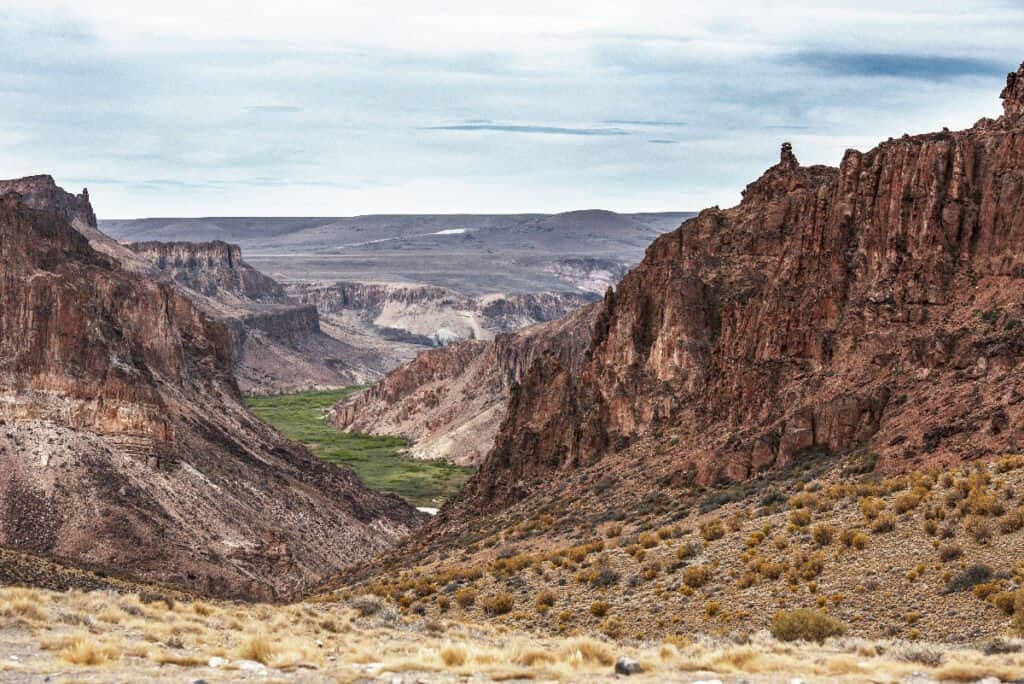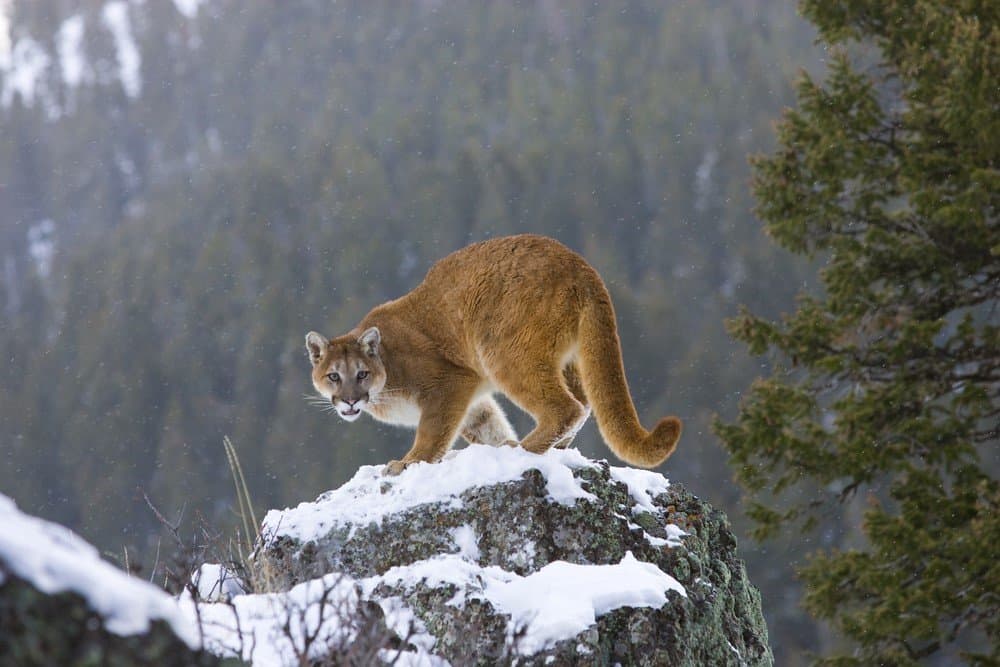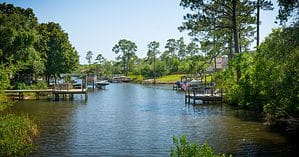The Patagonia region is well-known as a wild and beautiful place full of mountainous landscapes, wildlife, and hiking trails. Within this large area is the Patagonian Desert, an arid part of South America. While it may not receive much rainfall, it is still home to plenty of interesting plants and animals that call Patagonia home.
How Large Is the Patagonian Desert?

The Patagonian Desert is also called the Patagonian Steppe.
©Manu Iglesias/Shutterstock.com
The Patagonian desert is more than 200,000 square miles, and it makes up a large portion of the South American continent, especially the southern part. The shape of the Patagonian desert follows the shape of the continent, and it tapers off at the southern end. It is also known as the Patagonian Steppe.
The Patagonia region is much larger, almost 400,000 square miles, and it includes the Andes mountain range and other parts of South America. The Patagonian desert is one area with larger Patagonia.
There are multiple regions within the Patagonian desert, including national parks in both Chile and Argentina, where it is located. Torres del Paine National Park is a popular place for visitors, and it begins in the Patagonian Steppe and extends into the mountainous regions. It is a wonderful park to take in the natural beauty of this wild landscape.
Where Is the Patagonian Desert Located?
Patagonia is a region in South America, and it covers the southern tip of the continent across Argentina and Chile. The Patagonian desert, or Patagonian Steppe, makes up a significant portion of this area. While there are plenty of mountains nearby, the vast plains offer a unique landscape that many people like to explore.
The Andes Mountains form the western boundary of the Patagonian desert. Most popular tourist destinations and national parks are in the western part of the desert. Visitors can explore the Andes and the Steppe, seeing the different topography, plant life, and wildlife native to Patagonia.
To the east, the Atlantic Ocean forms the boundary of the Patagonia desert. It extends all the way to the coast. There is a notable archipelago of islands, including Tierra del Fuego, that follow the shape of the Patagonian desert to the west. They are included in the larger Patagonian region but are actually quite different in climate than the Steppe. These islands are south of the Strait of Magellan and glaciers are prominent in the area.
The northern boundary of the Patagonian desert is the Colorado River. The Cuyo region and the Pampas, two areas with mountains and vast plains, are north of the Steppe and similar to the Patagonian desert. They receive more rainfall, however.
What Is the Average Annual Rainfall in the Patagonian Desert?
The Patagonian desert is a rain shadow desert. This means that air that moves from the Pacific Ocean over the Andes mountains cools and loses moisture. This results in the green mountainous environment that makes the Andes popular with visitors. When the air gets to the Patagonian Steppe, it is dry. Not only does that limit the precipitation that falls, but it also sucks moisture from the existing air and climate.
The average annual rainfall is between 5 and 8 inches in Patagonia. The Steppe tends to be on the lower end of this average. There is no distinct rainy or dry season since most of the year is arid. Nearby, the rainy season in the Andes is from December to March. Rainfall is typically more common during the afternoon during this time. The Steppe still sees very little rainfall. When there is precipitation, it is more likely to be fog and dissipate very quickly.
The different regions of Patagonia all experience different amounts of rainfall but the Patagonian desert or Patagonian Steppe gets the least by far. The rainshadow created by the Andes mountains keeps precipitation from accumulating in the air, resulting in very little rain or snow.
What Are the Hottest, Coldest, and Average Temperatures in the Patagonian Desert?
The Patagonian desert is cold, not at all what you may expect when you think of a dry, sandy desert. Temperatures can get downright frigid during the night and winter months. This is not surprising, given its proximity to the Antarctic region in the south. Temperatures in the Patagonian Steppe vary both by subregion as well as season.
Summer Temperatures
The summer months start in December and run through February or March. Temperatures can be as high as 88 degrees Fahrenheit. The coast tends to be warmer than further inland, where temperatures average closer to 75 degrees Fahrenheit during the daytime. Nights get much colder, even during the summer. Temperatures on the Steppe can be as low as 44 degrees Fahrenheit. Frost is a common thing to see during both winter and summer.
Winter Temperatures
The winter season is much longer, spanning around 7 months of the year. It starts in March and goes through October or November. It makes up the majority of the year in the Patagonian Steppe and the region as a whole.
Coastal parts of the region tend to be milder during both summer and winter. During the day, winter temperatures are around 52 degrees Fahrenheit. Night temperatures get down to 35 degrees Fahrenheit, making special gear essential if you plan to camp or explore during the winter.
The inland areas of the desert get much colder. Average daytime temperatures are around 41 degrees Fahrenheit. Nighttime temperatures are closer to 23 degrees Fahrenheit. It is not uncommon for temperatures to fall to as low as -4 degrees Fahrenheit during cold spells.
Wildlife in the Patagonian Desert

Cougars can be found in the Patagonian Desert.
©S.R. Maglione/Shutterstock.com
There are some portions of grasslands that can support shrubs, long grass, and the animals that live in the Patagonian Desert. These animals include the Patagonian mara, some cougars, skunks, and other rodents. There are also plenty of birds, such as burrowing owls and lesser rhea, that live in these areas.
Other parts of the desert are covered with volcanic rock. There are significantly fewer plants and animals in these areas because the food sources are so few.
The photo featured at the top of this post is © Manu Iglesias/Shutterstock.com
Sources
- IUCN, Patagonian Steppe, Available here: https://www.iucn.org/content/patagonian-steppe
- LAC, Patagonian Desert, Available here: https://lacgeo.com/patagonian-desert-steppe-ecoregion
- Wilderness Travel, Available here: https://www.wildernesstravel.com/destination/latin-america/patagonia/parks
- Britannica, Available here: https://www.britannica.com/place/Patagonia-region-Argentina
Thank you for reading! Have some feedback for us? Contact the AZ Animals editorial team.







